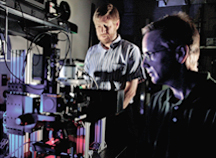
Sandia and Monsanto Company have announced a three-year, $1.5 million cooperative research and development agreement (CRADA) that is expected to play a role in both organizations’ interests in biology and bio- energy. The partnership is aimed at aligning Sandia’s capabilities in bio-analytical imaging and analysis with Monsanto’s research in developing new seed-based products for farmers, including corn products that may be able to produce more ethanol per bushel.
“A strategic relationship with Monsanto makes sense on many levels and will bolster our collective long-term objectives in bioenergy and bio-fuels,” says Terry Michalske, director of Biological and Energy Sciences Center 8300.
Recent biotechnology endeavors at Sandia have focused on developing and applying biotechnologies to identify early signs of infectious diseases through protein interactions and biomarkers at the single cell and whole organism scale. Sandia also is planning a key role in a multi-lab/university effort to bring a DOE-funded bio-research facility to the San Francisco Bay area. DOE’s Office of Science reissued a solicitation earlier this month for one or more such facilities, with a focus expected to be on cost-effective, biologically based renewable energy sources to reduce US dependence on fossil fuels.
The Monsanto CRADA will initially focus on hyperspectral fluorescence imaging and spectral analysis. Under the partnership, researchers from the two organizations will apply Sandia’s hyperspectral imaging and multivariate image analysis technology to aid in the study of plant tissue samples of interest to Monsanto. Hyperspectral imaging is an advanced scanning technology that provides significantly more information than other approaches, necessitating the use of sophisticated computational analysis.
The research is expected to enhance current crop analytical technologies, offering an additional technological resource to support Monsanto’s robust product discovery engine and development pipeline. Monsanto’s crop analytics research program has recently played a role in discovering new seed-based products for farmers, including corn hybrids that offer more ethanol-output per bushel and soybean varieties that produce healthier oils for consumers.
“Seeking out new and innovative scientific tools is an important part of how we bring forward new technologies for the farmer,” says Pradip Das, director of crop analytics for Monsanto. “This partnership provides Monsanto with a new opportunity to further bolster our existing crop analytics program, offering our researchers another way to better understand genomic profiles for seed and trait development.”
Sandia researchers in New Mexico will investigate, develop, and further advance the Labs’ hyperspectral imaging and multivariate data analysis methods and capabilities for agricultural product discovery and development applications.
Terry says researchers at the Combustion Research Facility could eventually benefit from the CRADA by gaining experience with agricultural samples that have bioenergy/biofuel applications and uses.
Ancillary research focusing on the photosynthetic properties of various plants and microbes, for instance, will add to the Lab’s growing expertise in understanding the conversion of sunlight to sugars, relevant not only to the production of new fuels from biomass but also essential to the global carbon cycle and carbon sequestration.